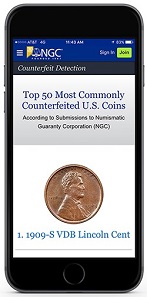October 19, 2017 – Numismatic Guaranty Corporation® (NGC®) has launched an online Counterfeit Detection resource, leveraging its decades of authentication expertise. Hosted at NGCcoin.com/counterfeits, the resource features the 50 US coins and 25 Chinese coins most commonly targeted by counterfeiters. Each of these coins has on its own page, with high-resolution images, the type of counterfeits of it typically seen, tips for detecting these counterfeits and other helpful information.
NGC’s online Counterfeit Detection resource. Photo: Numismatic Guaranty Corporation®.
This valuable resource was assembled under the direction of Rick Montgomery, NGC President, Finalizer and one of the world’s foremost coin authenticators. Many members of the NGC grading team also provided research and insights. NGC’s graders have identified more than 100,000 counterfeit and altered coins since 1987.
The resource puts a spotlight on such coins as the 1909-S VDB Lincoln Cent, the most commonly counterfeited US coin, according to submissions to NGC. The Year 23 (1934) Junk L&M-110 Dollar, named for the ship on its reverse, is the most commonly seen counterfeit of a Chinese coin, according to submissions to NGC.
Other highlights of the resource’s lists of counterfeit coins:
- The 1916-D Mercury Dime is the second most commonly seen U.S. counterfeit.
- All 15 issues of the Indian $2.50 that were minted in the early 1900s made the list of the top 50 U.S. counterfeits, comprising nearly a third of the list. The 2000 Silver Panda 10 Yuan, a modern coin popular with collectors, made the list of the top Chinese counterfeits at No. 15.
- The Year 17 (1928) Kweichow L&M-609 Dollar, often called the “Auto Dollar” because of the vehicle depicted on it, was among the top 10 Chinese counterfeit coins, which are all early 20th century dollars.
The Counterfeit Detection portal also includes a section that explains what distinguishes the different types of fakes, which include cast, spark erosion, electrotype and transfer die counterfeits, as well as altered dates and altered mintmarks.
Users can also easily access more than 100 articles NGC Counterfeit Detection articles that have been published in NGC’s newsletter. (Subscribers to the newsletter are among the first to know about new counterfeit research. Subscribe for free by creating an account at any membership level by clicking here.)
NGC’s Counterfeit Detection resource will continue to evolve. For instance, a section about the top 25 counterfeit world coins is being compiled and will be made available soon. Existing content will be updated as new discoveries are made.
Specialists and generalists alike can benefit from the information available in this free resource. To visit it, please click here.





